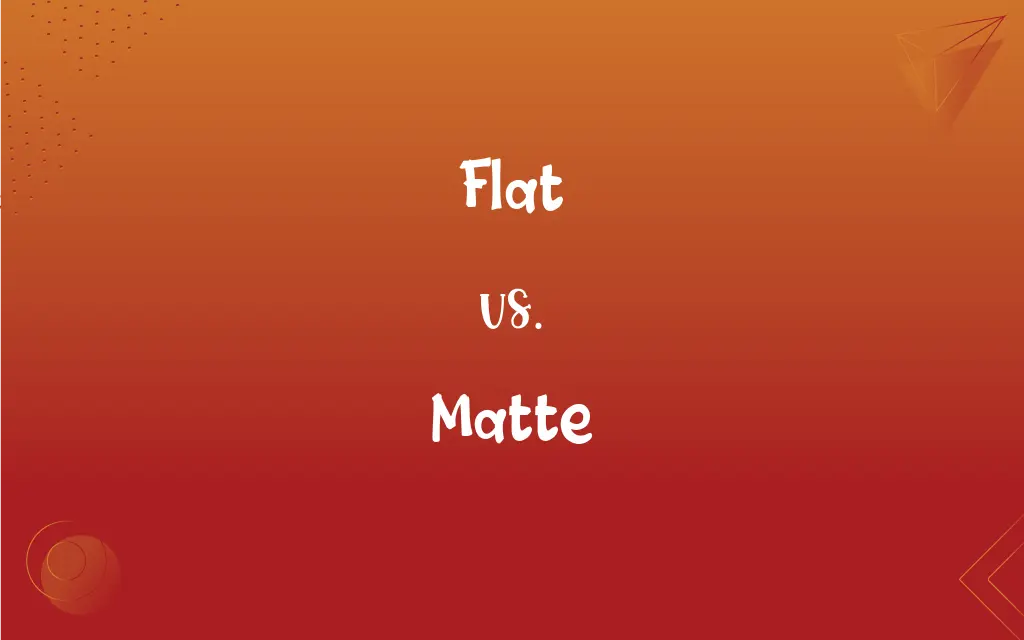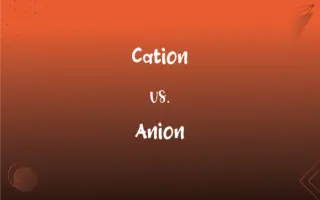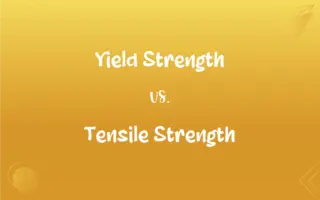Flat vs. Matte: What's the Difference?
Edited by Aimie Carlson || By Harlon Moss || Updated on October 12, 2023
Flat refers to a smooth, level surface or area with no irregularities or elevations. Matte refers to a non-reflective, low-gloss finish or surface.

Key Differences
Flat and matte are terms that, although sometimes used interchangeably, bear distinctive meanings in various contexts. Flat refers to a smooth and level surface that lacks elevations or depressions, while matte pertains to a dull and non-reflective finish, often relating to photography, printing, or materials like paint.
In interior design, a flat surface would denote an even, uniform area without textural deviations. On the other hand, matte describes the aesthetic of a surface, indicating it diffuses light, which minimizes the visibility of imperfections like scratches or dents due to its low sheen.
When dealing with paint finishes, flat typically describes a type of paint with no shine, often utilized to mask imperfections on walls and ceilings. Alternatively, matte paint, while also low in shine, has a slight luster, providing a balance between aesthetics and durability in various applications.
In the context of photography and printing, a flat image might be perceived as lacking dynamic range or contrast. Conversely, a matte photograph or print indicates the type of finish the photograph has, which would be dull and without glare, preferred for its anti-reflective qualities.
Flat can also allude to musical notes, implying a pitch that is slightly below the standard, whereas matte doesn’t engage in a musical context, further amplifying the diverse applications of the words. Thus, while flat and matte can both refer to absence of shine in some contexts, their specific applications can diverge notably.
ADVERTISEMENT
Comparison Chart
Basic Definition
Level and smooth
Low-gloss finish
Contextual Usage
Diverse
Mostly visual
Textural Implication
Implies uniformity
Implies no reflection
Musical Context
Pertinent
Not applicable
Application in Paint
Often used for ceilings
Balanced for various surfaces
ADVERTISEMENT
Flat and Matte Definitions
Flat
Having a level surface; without raised areas or indentations.
The table was completely flat, ensuring stability.
Matte
A matte image, photograph, or screen is one that does not have a shiny surface.
Photographers often prefer matte prints to avoid glare.
Flat
A set of rooms for living in, usually on one floor of a large building.
She rented a flat in the city center.
Matte
(of a color, paint, or surface) dull and flat, without a shine.
She chose a matte black for the wall color.
Flat
Lacking interest or emotion; dull and lifeless.
The actor’s flat performance failed to impress the audience.
Matte
Lacking transparency; opaque.
The matte glass provided privacy while still letting light through.
Flat
In music, lowered by a half step in pitch.
He played a B flat on the trumpet.
Matte
A decorative border around a picture to fit it into a frame of a larger size.
The artist placed a white matte around the colorful painting.
Flat
Absolute; outright.
He achieved a flat victory in the competition.
Matte
In film, a piece of scenery used to block the sight of the working areas of a set.
The film crew used a matte to conceal the lighting setup.
Flat
Having a smooth, even surface
A flat field.
Matte
Variant of mat2.
Matte
An opaque border or pattern placed between a source of light and a photosensitive surface to prevent exposure of specified portions of the surface.
FAQs
Is matte a term used to describe a non-reflective surface?
Yes, matte refers to a dull, non-reflective surface or finish.
Does flat always imply a complete lack of gloss in paint finishes?
Typically, yes, flat paints are often devoid of gloss or shine.
Can flat refer to a type of dwelling?
Yes, in some regions, a flat refers to an apartment or set of rooms for living.
Does a flat musical note have a lower pitch?
Yes, a flat note is played a half step lower in pitch.
Can a matte finish hide surface imperfections?
Yes, the non-reflective nature of matte finishes can minimize the visibility of imperfections.
Can both flat and matte finishes be used in photography?
Yes, but while matte describes a type of photo finish, flat might describe an image’s contrast.
Is matte paper suitable for photo printing?
Yes, matte paper is often chosen for its non-reflective properties in photo printing.
Is matte used in musical terminology?
No, matte is not typically used within a musical context.
Is matte always related to visual characteristics?
Predominantly, yes, matte often describes visual or tactile surface qualities.
Can a flat surface refer to a geographical feature?
Yes, flat can describe a level landform without significant elevations.
Does a flat tire refer to a deflated tire?
Yes, a flat tire refers to a tire that is deflated and lacks the necessary air pressure.
Can a narrative be described as flat?
Yes, a flat narrative implies a lack of excitement or dynamic elements.
Is matte finish considered modern in interior design?
Matte finishes are popular in modern design for their chic, understated appearance.
Can a surface be both flat and matte?
Yes, a surface can be flat (smooth and level) and have a matte (non-glossy) finish.
Does flat paint have more sheen than matte paint?
No, flat paint typically has less sheen than matte paint.
Does a flat character in literature display dynamic traits?
No, flat characters are typically straightforward and lack development.
Do matte surfaces repel light?
Matte surfaces diffuse light, reducing glare and reflections.
Does flat imply a lack of surface texture?
Yes, flat generally implies a smooth, even surface without raised areas.
Can matte be related to a border around pictures?
Yes, a matte can refer to a border or frame around images or artwork.
Can a surface have a matte texture?
Matte describes a surface’s finish, not its texture, but is perceived as non-shiny.
About Author
Written by
Harlon MossHarlon is a seasoned quality moderator and accomplished content writer for Difference Wiki. An alumnus of the prestigious University of California, he earned his degree in Computer Science. Leveraging his academic background, Harlon brings a meticulous and informed perspective to his work, ensuring content accuracy and excellence.
Edited by
Aimie CarlsonAimie Carlson, holding a master's degree in English literature, is a fervent English language enthusiast. She lends her writing talents to Difference Wiki, a prominent website that specializes in comparisons, offering readers insightful analyses that both captivate and inform.































































